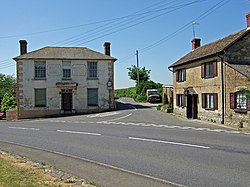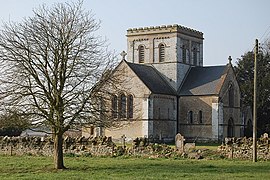East Stour, Dorset
| East Stour | |
| Dorset | |
|---|---|
 East Stour | |
| Location | |
| Grid reference: | ST799229 |
| Location: | 51°0’19"N, 2°17’15"W |
| Data | |
| Population: | 573 (2011) |
| Post town: | Gillingham |
| Postcode: | SP8 |
| Dialling code: | 01747 |
| Local Government | |
| Council: | Dorset |
| Parliamentary constituency: |
North Dorset |
East Stour is a village in Dorset, in the north of the county about two miles south of the town of Gillingham (and in the Gillingham Hundred).
The village is sited half a mile from the east bank of the River Stour, while its sister village, West Stour, is mile away to the west, on the opposite bank of the river. The villages sit in the Blackmore Vale and East Stour is two miles west of the broadly conical local landmark, Duncliffe Hill (689 feet). The A30 London to Penzance road passes through the village. The 2011 census found a population in the civil parish of 573.
History
Part of the shaft of a cross, probably dating from the late 10th or early 11th century, was found in 1939 when a house in the village was demolished. The stone fragment has a cross-section a little under one foot square and is about 2 feet high; its faces are embellished with vine-scroll, interlace and palmette ornament. It was transferred to the British Museum.[1]
In the Domesday Book of 1086 East Stour and West Stour together were recorded as Stur or Sture,[2] which had 73 households.
A 1695 map shows the village name as Stower Estover.
East Stour village was the original settlement in the parish. A study of field boundaries has suggested that encroachment on the "waste" or common land subsequently occurred eastwards, initially immediately east of the village, then further east in the early Modern Period. The farms at New House and Cole Street in the north-east of the parish date from settlement in the late 18th century, and in the south-east the waste was enclosed in 1804.[1]
Parish church
The parish church, Christ Church, was rebuilt in 1841–42 near the site of its predecessor. It contains a Norman stone font, retrieved from the previous church.
About the village
The manor house was for many years the residence of the writer and magistrate Henry Fielding (1707—1754), who also founded the Bow Street Runners, lived in the manor house for three years, after inheriting it. During this time he spent his fortune and consequently became a professional writer. The house, sited west of the church, was demolished in 1835, though its mullioned windows were probably incorporated into its replacement, which previously was called Fielding's Farm but in 1919 became Church Farm.[3][4]
East Stour has a village hall[5] and two public houses: The Crown Inn on the B3092 towards Gillingham and The Kings Arms at East Stour Common.[6][7]
Outside links
| ("Wikimedia Commons" has material about East Stour, Dorset) |
References
- ↑ 1.0 1.1 East Stour: An Inventory of the Historical Monuments in Dorset, Volume 4, pages 16–17
- ↑ "Dorset S–Z". The Domesday Book Online. domesdaybook.co.uk. http://www.domesdaybook.co.uk/dorset3.html. Retrieved 7 July 2014.
- ↑ Hyams, John (1970). Dorset. B T Batsford Ltd. p. 201. ISBN 0-7134-0066-8.
- ↑ White, Steve; Hannay, Clive (November 2011). "From Shaftesbury towards Stalbridge". Dorset Life Magazine. http://www.dorsetlife.co.uk/2011/11/from-shaftesbury-towards-stalbridge/. Retrieved 22 September 2015.
- ↑ "East Stour Village Hall". Dorset Halls Network. Dorset Village Halls Association. 2012. http://www.dorsethalls.net/content/east-stour-village-hall. Retrieved 15 March 2015.
- ↑ "The Crown Inn". pub-explorer.com. http://www.pub-explorer.com/olpg/crowninn/east_stour/index.htm. Retrieved 15 March 2015.
- ↑ "The Kings Arms". kingsarmseaststour.com. http://www.kingsarmseaststour.com/. Retrieved 15 March 2015.
